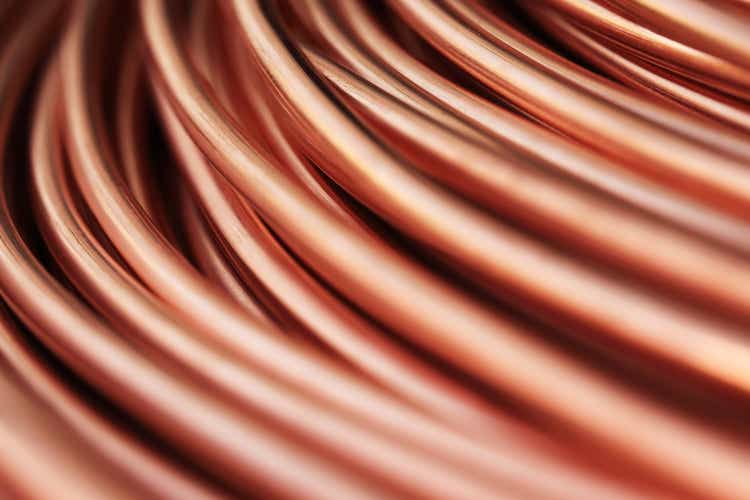tunart/E+ via Getty Images
By Wenyu Yao
Copper prices have held up relatively well during the first three months of the year, gaining over 7% year-to-date at the time of writing. On a quarterly average basis, 3M copper prices rose by 3.9% from 4Q21. The absolute gains in outright prices and market volatility pale in comparison with other metals such as aluminium (+26% ytd) and zinc (+16% ytd), pricing in the risk premium from the Ukraine war, as well as nickel where the unprecedented short squeeze had pushed prices to an extreme level in early March.
Before the Ukraine war, the red metal’s trading was stuck in a quandary while evaluating how the economies would fare since the US and China are taking diametrically opposite monetary and fiscal policy stances. Recent developments not only helped to reinforce this policy trajectory but also brought some new twists.
On the one hand, the heightening inflationary pressure amid rising prices across the whole commodities board post the Ukraine war has forced the Fed to embark on a more aggressive hawkish stance. With US prices hitting a 40-year high in February and showing no signs of easing, inflation is perceived as the biggest risk to the real economy insofar as markets and some investors seemed to believe that the Fed’s credibility to rein in inflation is far more meaningful than the post-pandemic recovery. This, coupled with yet a still robust underlying economy, has seen copper together with its peers in the metals complex largely ignore the headwinds from a stronger currency (US dollar) they are priced with.
In the meantime, trend-following funds continue to cash in on rampant inflation and pile into commodities, real assets for a hedge, which has supported metals prices. Nevertheless, commodities have enemies of their own because volatility has surged across the whole complex and multiple commodities have seen outsized moves in recent weeks, requiring larger liquidity to cover their trades. Some margin-strapped traders may have been forced to unwind or sit on the sidelines, particularly after the unprecedented nickel squeeze on 8 March. From mid-March, investment funds have trimmed their exposures to copper and other metals across both COMEX and LME, leaving liquidity thin across markets.
On the other hand, the recent Covid outbreak in China clearly threw a curveball into the seasonal demand pick-up. Multiple cities have had different degrees of snap lockdowns, causing disruptions to logistics. However, the net impact on metals is still less clear cut. Previous outbreaks have proved that the supply-side tends to be hit harder than demand at the earlier stage. Beijing stated during the Two-Sessions at the beginning of March that stability is of paramount priority in their policy agenda and China is sticking to a 5.5% GDP growth target. Therefore, it is assumed that the Covid outbreak may provide some leeway for policymakers to launch more stimulus packages. That said, monetary and fiscal policies in China, opposite to that in the US, are moving towards more easing and stimulus. Hence, despite some of the high-frequency indicators showing a mixed picture of a healthier economic and demand optics in the short term, it is still expected that copper demand will pick up later after the Covid cases peak.
Fundamental wise, LME inventories started to rise modestly as recent market dislocation between London and Shanghai incentivised exports from China. Nevertheless, exports are rare compared to China’s usual status as a large net importer. Smelters may export copper under tolling business, and traders may ship bonded copper to nearby LME warehouses to take advantage of the stronger prices in the ex-China market while the domestic market is still on the soft side. Such a mechanism usually helps bridge the gap between the two markets in a certain period. Part of the ramifications is that the front end of spreads in LME has eased in the last couple of weeks. We do not expect exports to stay sustained once the dislocation between the two markets is rebalanced. With demand picking up in the onshore market later supporting the Shanghai market, all things being equal, we think exports should subside and support the LME spread.
Currently, the market still faces large uncertainties around the inflation trajectory and the Fed’s policy path, the Ukraine war and China’s Covid battle. Spikes in market volatility cannot be ruled out while liquidity is thin. All things considered, as a base case, we currently expect the price to average around US$10,000 (LME 3M) in the next quarter, and a more bullish scenario is for the price to re-test the highs seen back in early March before moderating later this year. Meanwhile, the largest downside risks could be that a forceful policy required to curb inflation negatively spills over to financial sentiment and the real economy, and a prolonged Covid combat could hurt demand harder as Beijing insists on its current policies on the virus.
Content Disclaimer
This publication has been prepared by ING solely for information purposes irrespective of a particular user’s means, financial situation or investment objectives. The information does not constitute investment recommendation, and nor is it investment, legal or tax advice or an offer or solicitation to purchase or sell any financial instrument. Read more
Editor’s Note: The summary bullets for this article were chosen by Seeking Alpha editors.


Be the first to comment